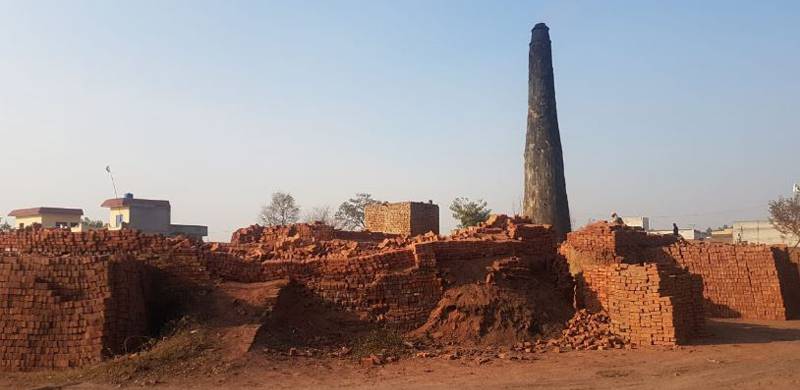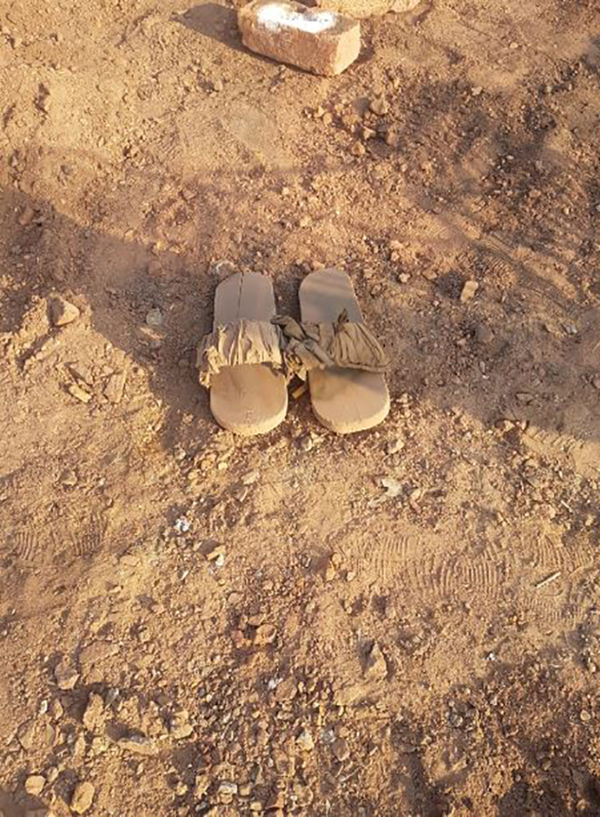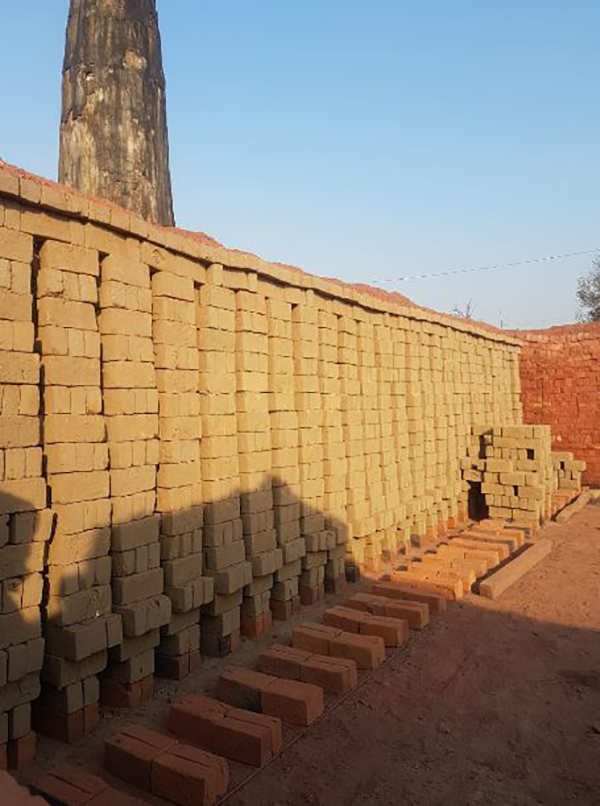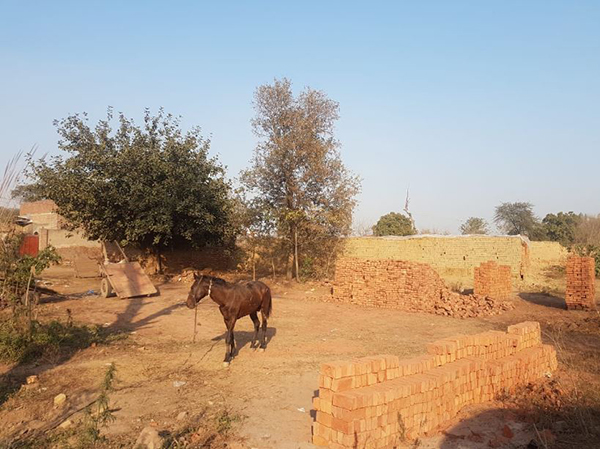
“It’s as if mother nature herself is against my marriage,” says Rehanna, 20, who has been engaged to be married for two years now. That’s a little longer than she wanted, and much longer than her family estimated it would take them to save up for her wedding. But, after a long day of work at a brick kiln in the outskirts of Kasur, a city located to the south of Lahore, Pakistan, Rehanna claims that her life is in the hands of nature and the government.
Rehanna has been moulding wet clay into bricks along with her sisters and mother, for as long as she can remember. “It’s back breaking work. At the end of the day, you don’t have energy to think or complain,” she says. “But we are in debt of the brick kiln owner, and he won’t let us find other work till we pay him back.”
This may take a long time. The wages of brick makers are PKR1 per brick. On a good day, Rehanna’s family collectively earns PKR700 per day. Wages are paid every Friday.

Until a few months ago, Rehanna thought nothing could be worse than working at the kiln. Then the Punjab government ordained that all brick kilns in the province be shut for 70 days in order to curb the smog that arrives in Punjab at the start of winter.
The truth is that air quality in the region is terrible year round, but since air quality is only visible in winter months via the smog, government policies, so far, are focused on winter. Lahore, the country’s second largest city, is hit hardest by the air pollution and smog, a mix of SO2, NO2, CO, particulate matter PM2.5 and PM10, trace metals and other poisonous chemicals. Urban air pollution in Pakistan is among the most severe in the world and is capable of significantly damaging human health and the country’s economy.
https://www.youtube.com/watch?v=qIHc0BtdR5U
When the kiln shut down, Rehanna realized that things could always get worse. Her family’s meagre income disappeared, they began using her wedding savings to feed themselves, hence pushing her marriage plans even further.
In the outskirts of Lahore, Rukhsana, 35, another brick molder tells a similar story. When the kiln her family works at was shut down, she found work cleaning houses in the city so that her family had enough to eat. “It didn’t help that all this happened just as winter was coming. We have to buy provisions to stay warm,” says Rukhsana. “Does no one think about us when they make these big decisions?”
https://www.youtube.com/watch?v=9bSABDxW3ik
One would think that nature wouldn’t know how to discriminate between rich and poor, man and woman. But in the case of Lahore’s air pollution, referred to as smog, this has proven untrue. Those hit hardest by the government’s fight against the smog have been the poor.
Mehar Abdul Haq, the secretary general of All Pakistan Kiln Owners’ Association says that about 500,000 families work for the approximately 10,000 brick kilns across Punjab. Each family comprises of about 5 people, that’s 2,500,000 affected people – half of whom are women.
Are the brick kilns to blame?
The smog first appeared about four years ago. But it was only in 2017 that the Lahore High Court created the Smog Commission to formulate a Smog Policy for Punjab. The policy report described that the “scant data available” about the concentration of air pollutants is “sporadic”, “narrow”, and “intermittent”. Despite the limited data, the report recommended curbing emissions from factories, closing brick kilns that fail to use fuel-efficient technology, and fining polluting vehicles and farmers burning rice stubble in the winter.
Out of these recommendations, the two sectors the government hit the hardest were the kiln owners and the rice farmers. Why?

The kilns aren’t faultless. Brick kilns often use low-grade coal and fuel mixes that include rubber tires, lignite coal, rice husk residues or plastics – this causes black dense smoke and major air pollutant emissions. In fact, after the cement sector, brick kilns are the largest consumers of coal in the country. But this also begs why the Punjab government did not think of asking the cement industry to halt its processes for 70 days?
In fact, a Greenpeace NO2 emission study conducted in July 2018 concluded that the main sources of air pollution were road transportation (40 per cent) and power generation (23 per cent).
Similarly, the Food and Agriculture Organization of the United Nations (FAO) report published in January 2019 concludes that 43 per cent of total air pollutant emissions are coming from the transport sector, about 20 per cent of the fault lies on rice residue burning, 12 per cent of the blame is accrued to the power sector, and the remaining 25 per cent can be divided between various industries, within which brick kiln emissions are included.
https://www.youtube.com/watch?v=W80ApQitLuQ
Environmental lawyer Rafay Alam believes that the shutting down of the kilns was a politically expedient move. “The government had to be seen doing something, and in this case the kiln association was already volunteering to shut themselves down, so the government latched on to the opportunity,” says Alam.
“Brick kilns and crop residue burning are both easy targets because they get public attention. Anyone traveling on the Ring Road in Lahore sees them in operation, and that leads to a false bias that kilns are the problem,” says Abid Omar, the founder of Pakistan Air Quality Initiative (PAQI). “These are populist reactions taken by a government that has not done a root cause analysis, and does not realize the extent of the problem.”
Another reason the kilns were hit hard was because the All Pakistan Kiln Owners’ Association volunteered to shut themselves down. “In the middle of 2018, we volunteered to the government that we will close our kilns during the smog season,” says Haq of the brick kiln Association. “We thought this will give the government time to clamp down on other causes of smog, such as creating awareness about vehicular emissions, but none of that really happened.”
https://www.youtube.com/watch?v=nYz3MhDyq8k
Haq says that the Kiln association volunteered themselves “for the sake of humanity”. Alam says that at an Environmental Protection Department (EPD) meeting when Haq was cynically asked why he was voluntarily sacrificing the kilns he said that the brick kiln association has a bad reputation and it was time to fix it.
This much is true. Brick kilns have historically been accused of bonded labour; underpaying labourers, especially women; terrible working conditions; lack of safety measures; physical and sexual abuse of women; and of employing child labour. Several laws have been put into place to improve labour conditions for kiln workers, but implementation is weak.
Was the kiln ban successful?
The answer depends on how one measures success, or who is measuring it. Haq from the Association claims that the early arrival of the rainy season cleared out the smog and the government is celebrating this as a victory of their policies.
According to PAQI’s data the concentration of PM2.5 in the atmosphere between October-December 2018 was lower than that in 2017. But EPD’s own data shows that the concentration increased this year.

PAQI’s Omar believes that the change in the year is due to meteorological phenomena, and not due to any government actions. “The brick kilns were not shut down, they were merely ‘scheduled’ to be shut down in certain areas, and that too on days when the pollution levels were high,” says Omar. There is no data available on how many kilns actually shut down and for how long. In any case, like the FAO and Greenpeace report, he estimates that the overall contribution of brick kilns to air quality is not more than 10 per cent.
Losers of the ban also include kiln workers. Some workers, like Rehanna and Rukhsana, say they didn’t get a cent during the shutdown. Others say they received delayed payments which worsened their debts. Some reported that their kilns didn’t actually shut down, but kiln owners used the government ban as an excuse to lessen or delay their payments.
Haq, however, says that the Association didn’t hold out on a single worker’s pay. “The brick makers, which is what women mostly do, were asked to keep moulding the bricks, and we were paying them the regular rates. We simply weren’t baking the bricks,” he said. “The kiln owners were the ones experiencing losses during this time.”
https://www.youtube.com/watch?v=6ppo9aBjtkc
Syeda Ghulam Fatima, General Secretary, Bonded Labour Liberation Front disagrees. She tells a local newsmagazine that the decision to shut down the kilns is anti-labour rather than anti-smog. “This is a joyous moment for owners since their profits will soar, but there is no authority to ensure the labour rights and counter the unfair price-hike,” she tells the magazine.
Fatima has a point; labourers were not taken into consideration when power holders decided how to tackle smog. And then there are those like Rehanna, who face the additional disadvantage of being female. Climate activists the world over, are beginning to realise that it is women like Rehanna and Rukhsana, who manage water, sources for fuel, health, and food for their families and hence they are most affected by environmental degradation and climate change.
One way to counter this is to add more women to the decision making processes and to debate around environmental issues. Pakistan has been slow to catch on to this idea. Only two of the thirteen members of the Smog Commission were women, and each of the five committees it formed were chaired by men.
https://www.youtube.com/watch?v=2F74K3UCjqA
What is the way forward?
Haq and the government seem adamant that the only way forward for brick kilns is by installing ZigZag technology. This Nepali technology is meant to enhance fuel efficiency, save energy and reduce emissions up to 70 per cent. It requires an initial investment of PKR25 lakh, but its monetary returns are worth it for the kiln owners.
The big downside to the technology is that Punjab does not have enough trained technicians to set it up swiftly. “It could take many, many years for Punjab’s 10,000 brick kilns to be shifted to Zig Zag,” admits Haq.
Environmental lawyer Alam says, “The zig zag technology is not the only solution available to kiln owners. For instance, there are other types of scrubbers that can be installed to reduce emissions.” He again reiterates that the government is always trying to find the “silver bullet solution” to environmental problems instead of thinking holistically.
This year the government was able to make a show of shutting down the kilns, upsetting labourers and unsettling construction prices, but this short-sighted plan does not seem economically viable in the years to come.
A Climate Tracker reporting grant helped fund this feature story.
Rehanna has been moulding wet clay into bricks along with her sisters and mother, for as long as she can remember. “It’s back breaking work. At the end of the day, you don’t have energy to think or complain,” she says. “But we are in debt of the brick kiln owner, and he won’t let us find other work till we pay him back.”
This may take a long time. The wages of brick makers are PKR1 per brick. On a good day, Rehanna’s family collectively earns PKR700 per day. Wages are paid every Friday.

Until a few months ago, Rehanna thought nothing could be worse than working at the kiln. Then the Punjab government ordained that all brick kilns in the province be shut for 70 days in order to curb the smog that arrives in Punjab at the start of winter.
The truth is that air quality in the region is terrible year round, but since air quality is only visible in winter months via the smog, government policies, so far, are focused on winter. Lahore, the country’s second largest city, is hit hardest by the air pollution and smog, a mix of SO2, NO2, CO, particulate matter PM2.5 and PM10, trace metals and other poisonous chemicals. Urban air pollution in Pakistan is among the most severe in the world and is capable of significantly damaging human health and the country’s economy.
https://www.youtube.com/watch?v=qIHc0BtdR5U
When the kiln shut down, Rehanna realized that things could always get worse. Her family’s meagre income disappeared, they began using her wedding savings to feed themselves, hence pushing her marriage plans even further.
In the outskirts of Lahore, Rukhsana, 35, another brick molder tells a similar story. When the kiln her family works at was shut down, she found work cleaning houses in the city so that her family had enough to eat. “It didn’t help that all this happened just as winter was coming. We have to buy provisions to stay warm,” says Rukhsana. “Does no one think about us when they make these big decisions?”
https://www.youtube.com/watch?v=9bSABDxW3ik
One would think that nature wouldn’t know how to discriminate between rich and poor, man and woman. But in the case of Lahore’s air pollution, referred to as smog, this has proven untrue. Those hit hardest by the government’s fight against the smog have been the poor.
Mehar Abdul Haq, the secretary general of All Pakistan Kiln Owners’ Association says that about 500,000 families work for the approximately 10,000 brick kilns across Punjab. Each family comprises of about 5 people, that’s 2,500,000 affected people – half of whom are women.
Are the brick kilns to blame?
The smog first appeared about four years ago. But it was only in 2017 that the Lahore High Court created the Smog Commission to formulate a Smog Policy for Punjab. The policy report described that the “scant data available” about the concentration of air pollutants is “sporadic”, “narrow”, and “intermittent”. Despite the limited data, the report recommended curbing emissions from factories, closing brick kilns that fail to use fuel-efficient technology, and fining polluting vehicles and farmers burning rice stubble in the winter.
Out of these recommendations, the two sectors the government hit the hardest were the kiln owners and the rice farmers. Why?

The kilns aren’t faultless. Brick kilns often use low-grade coal and fuel mixes that include rubber tires, lignite coal, rice husk residues or plastics – this causes black dense smoke and major air pollutant emissions. In fact, after the cement sector, brick kilns are the largest consumers of coal in the country. But this also begs why the Punjab government did not think of asking the cement industry to halt its processes for 70 days?
In fact, a Greenpeace NO2 emission study conducted in July 2018 concluded that the main sources of air pollution were road transportation (40 per cent) and power generation (23 per cent).
Similarly, the Food and Agriculture Organization of the United Nations (FAO) report published in January 2019 concludes that 43 per cent of total air pollutant emissions are coming from the transport sector, about 20 per cent of the fault lies on rice residue burning, 12 per cent of the blame is accrued to the power sector, and the remaining 25 per cent can be divided between various industries, within which brick kiln emissions are included.
https://www.youtube.com/watch?v=W80ApQitLuQ
Environmental lawyer Rafay Alam believes that the shutting down of the kilns was a politically expedient move. “The government had to be seen doing something, and in this case the kiln association was already volunteering to shut themselves down, so the government latched on to the opportunity,” says Alam.
“Brick kilns and crop residue burning are both easy targets because they get public attention. Anyone traveling on the Ring Road in Lahore sees them in operation, and that leads to a false bias that kilns are the problem,” says Abid Omar, the founder of Pakistan Air Quality Initiative (PAQI). “These are populist reactions taken by a government that has not done a root cause analysis, and does not realize the extent of the problem.”
Another reason the kilns were hit hard was because the All Pakistan Kiln Owners’ Association volunteered to shut themselves down. “In the middle of 2018, we volunteered to the government that we will close our kilns during the smog season,” says Haq of the brick kiln Association. “We thought this will give the government time to clamp down on other causes of smog, such as creating awareness about vehicular emissions, but none of that really happened.”
https://www.youtube.com/watch?v=nYz3MhDyq8k
Haq says that the Kiln association volunteered themselves “for the sake of humanity”. Alam says that at an Environmental Protection Department (EPD) meeting when Haq was cynically asked why he was voluntarily sacrificing the kilns he said that the brick kiln association has a bad reputation and it was time to fix it.
This much is true. Brick kilns have historically been accused of bonded labour; underpaying labourers, especially women; terrible working conditions; lack of safety measures; physical and sexual abuse of women; and of employing child labour. Several laws have been put into place to improve labour conditions for kiln workers, but implementation is weak.
Was the kiln ban successful?
The answer depends on how one measures success, or who is measuring it. Haq from the Association claims that the early arrival of the rainy season cleared out the smog and the government is celebrating this as a victory of their policies.
According to PAQI’s data the concentration of PM2.5 in the atmosphere between October-December 2018 was lower than that in 2017. But EPD’s own data shows that the concentration increased this year.

PAQI’s Omar believes that the change in the year is due to meteorological phenomena, and not due to any government actions. “The brick kilns were not shut down, they were merely ‘scheduled’ to be shut down in certain areas, and that too on days when the pollution levels were high,” says Omar. There is no data available on how many kilns actually shut down and for how long. In any case, like the FAO and Greenpeace report, he estimates that the overall contribution of brick kilns to air quality is not more than 10 per cent.
Losers of the ban also include kiln workers. Some workers, like Rehanna and Rukhsana, say they didn’t get a cent during the shutdown. Others say they received delayed payments which worsened their debts. Some reported that their kilns didn’t actually shut down, but kiln owners used the government ban as an excuse to lessen or delay their payments.
Haq, however, says that the Association didn’t hold out on a single worker’s pay. “The brick makers, which is what women mostly do, were asked to keep moulding the bricks, and we were paying them the regular rates. We simply weren’t baking the bricks,” he said. “The kiln owners were the ones experiencing losses during this time.”
https://www.youtube.com/watch?v=6ppo9aBjtkc
Syeda Ghulam Fatima, General Secretary, Bonded Labour Liberation Front disagrees. She tells a local newsmagazine that the decision to shut down the kilns is anti-labour rather than anti-smog. “This is a joyous moment for owners since their profits will soar, but there is no authority to ensure the labour rights and counter the unfair price-hike,” she tells the magazine.
Fatima has a point; labourers were not taken into consideration when power holders decided how to tackle smog. And then there are those like Rehanna, who face the additional disadvantage of being female. Climate activists the world over, are beginning to realise that it is women like Rehanna and Rukhsana, who manage water, sources for fuel, health, and food for their families and hence they are most affected by environmental degradation and climate change.
One way to counter this is to add more women to the decision making processes and to debate around environmental issues. Pakistan has been slow to catch on to this idea. Only two of the thirteen members of the Smog Commission were women, and each of the five committees it formed were chaired by men.
https://www.youtube.com/watch?v=2F74K3UCjqA
What is the way forward?
Haq and the government seem adamant that the only way forward for brick kilns is by installing ZigZag technology. This Nepali technology is meant to enhance fuel efficiency, save energy and reduce emissions up to 70 per cent. It requires an initial investment of PKR25 lakh, but its monetary returns are worth it for the kiln owners.
The big downside to the technology is that Punjab does not have enough trained technicians to set it up swiftly. “It could take many, many years for Punjab’s 10,000 brick kilns to be shifted to Zig Zag,” admits Haq.
Environmental lawyer Alam says, “The zig zag technology is not the only solution available to kiln owners. For instance, there are other types of scrubbers that can be installed to reduce emissions.” He again reiterates that the government is always trying to find the “silver bullet solution” to environmental problems instead of thinking holistically.
This year the government was able to make a show of shutting down the kilns, upsetting labourers and unsettling construction prices, but this short-sighted plan does not seem economically viable in the years to come.
A Climate Tracker reporting grant helped fund this feature story.
